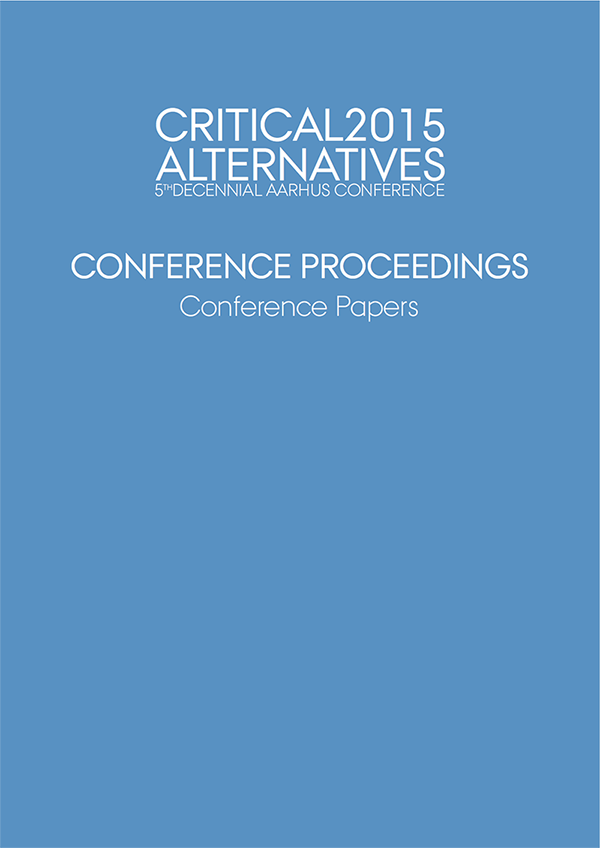Gaza Everywhere: exploring the applicability of a rhetorical lens in HCI
DOI:
https://doi.org/10.7146/aahcc.v1i1.21314Keywords:
Visual Enthymeme, Rhetoric, Persuasive Technology, Experience Design, Design TheoryAbstract
By examining application software as a type of rhetorical artifact, it is possible to highlight its social, ethical and moral implications. In this paper, we explore one possibility for such a lens: application software functioning as a visual enthymeme. To explore the applicability of that concept in HCI, we analyze one web application as a first step. In our analysis, we observe that interaction and usability are two features that support an application in functioning as a visu- al enthymeme. Also, online sharing could help the user take the role of the arguer. Our analysis allows us to outline the elements of a user-centric persuasive experience and shows promise for further explorations regarding the applicability of rhetoric in HCI.
References
Arvola,M.TheMediatedActionSheets:AFramework for the Fuzzy Front-End of Interaction and Service De- sign. Proc. European Academy of Design Conference, (2013).
Bardzell,J.InteractionCriticism:Anintroductiontothe practice. Interacting with Computers 23, 6 (2011), 604- 621. Elsevier.
Barlett,E.GazaEverywhereapphighlightstruescaleof humanitarian crisis. i100 from The Independent (August 14, 2014). Shortened URL: http://goo.gl/b3t2lV
Bostrom,R.N.Persuasion.Pretince-Hall,1983.
Buchanan, R. Declaration by Design: Rhetoric, Argu- ment, and Demonstration in Design Practice. Design Is- sues 2,1 (1985) 4-22.
Carnegie,T.A.M.InterfaceasExordium:TheRhetoric of Interactivity. Computers and Composition 26, 3 (2009) 164-173. Elsevier.
Covino, W.A., & Jolliffe, D.A. Rhetoric: concepts, defi- nitions, boundaries. Allyn and Bacon, 1995.
Ehses,H.,&Lupton,E.RhetoricalHandbook.AnIllus- trated Manual for Graphic Designers. Design Papers 5 (1988), 1-39.
Fogg,B.J.(1998).PersuasiveComputers:Perspective and Research Directions. In Proc. CHI ’98. ACM Press/Addison-Wesley (1998), 225-232
Foss, S.K., Foss, K.A., & Trapp, R. Contemporary Per- spectives on Rhetoric. 2nd Edition. Waveland Press, 1991.
Getto, G., Potts, L., & Salvo, M.J. Teaching UX: De- signing Programs to Train the Next Generation of UX Experts. SIGDOC ’13. ACM Press (2013), 65-69.
Handa, C. Visual Rhetoric in a Digital World. Bed- ford/St. Martin Press, 2004.
Hill, C.A., & Helmers, M. (Eds.) Defining Visual Rheto- rics. Lawrence Erlbaum Associates, 2004.
Hullman, J., & Diakopoulos, N. Visualization Rhetoric: Framing Effects in Narrative Visualization. T. on Visu- alization and Computer Graphics 7, 12 (2011) 2231- 2240
Kannabiran, G., & Graves Petersen, M. Politics at the interface: A Foucauldian power analysis. In Proc. Nor- diCHI 2010. ACM Press (2010), 695-698.
Nassri, A. Gaza Everywhere (2014, August 8). URL: http://ahmadnassri.github.io/gaza-everywhere/
Nelson, H.G., & Stolerman, E. The Design Way. MIT Press, 2012
Price, J. A Rhetoric of Objects. SIGDOC ’01. ACM Press (2001), 147-151 .
Redström, J. Persuasive Design: Fringes and Founda- tions. W. IJsselsteijn et al. (Eds.) PERSUASIVE 2006, LNCS 3962 (2006), 112-122. Springer.
Rosinki, P., & Squire, M. Strange Bedfellows: Human- Computer Interaction, Interface Design and Composi- tion Pedagogy. Computers and Composition 26, 3 (2009), 149-163. Elsevier.
Schön, D.A. The Reflective Practitioner. How Profes- sionals Think In Action. Basic Books, 1984.
Sosa-Tzec, O., & Siegel, M.A. Rhetorical Evaluation of User Interfaces. NordiCHI ’14. ACM Press (2014), 175- 178.
Torning, K., & Oinas-Kukkonen, H. Persuasive System Design: State of the Art and Future Directions. Persua- sive ’09, ACM Press (2009).
Kord. Y., IJsselsteijn, W., Midden, C., Eggen B., Fogg, B.J. (Eds.) Persuasive Technology. 2nd International ConferenceonPersuasiveTechnology,PERSUASIVE 2007. Revised Selected Papers. Springer (2007).




